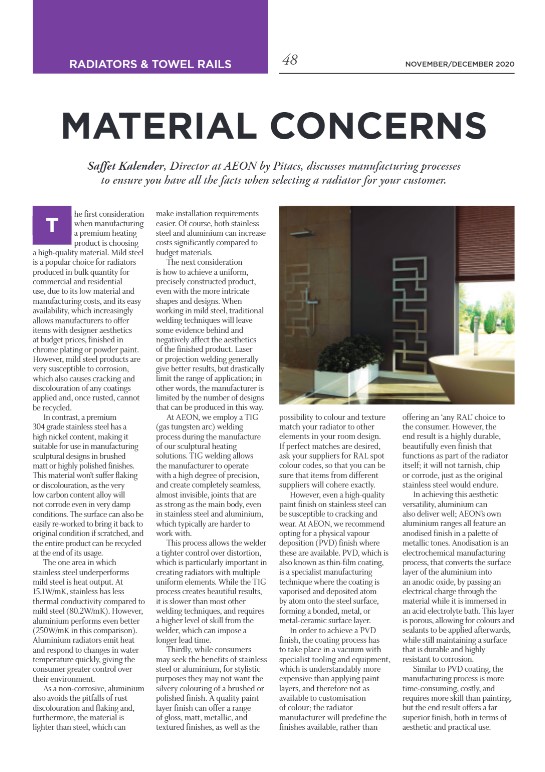| Featured in HVP Magazine November/December 2020 |
Material
The first consideration when manufacturing a premium heating product is choosing a high-quality material. Mild steel is a popular choice for radiators produced in bulk quantity for commercial and residential use, and increasingly allows manufacturers to offer items with designer aesthetics at budget prices, finished in chrome electroplating or paint. However, mild steel products are very susceptible to corrosion, which also causes cracking and discolouration of any coatings applied. In contrast, a premium 304 grade stainless steel has a high nickel content, ideal for use in manufacturing exceptional, sculptural designs in beautiful brushed matt or highly polished finishes. This material won’t suffer flaking or discolouration, as the low iron content alloy will not corrode even in very damp conditions.
Stainless steel is also a more efficient heat conductor than its mild steel equivalent. However, aluminium performs even better. Aluminium radiators both emit heat and respond to changes in water temperature quickly, which gives the consumer greater control over their environment. As a non-corrosive, Aluminium also avoids the pitfalls of discolouration and flaking when painted or plated, and furthermore, the material is lighter than steel, which can make installation requirements easier. Of course, both stainless steel and aluminium can increase costs significantly compared to budget materials.

Construction
The next consideration is how to achieve a uniform, precisely constructed product, even with the more intricate shapes and designs. Stainless steel, for example, can be welded with shielded metal arc welding (MIG), which is generally the more cost effective, time efficient process, and also one of the simpler processes, requiring less skill and experience on the part of the welder, which can also drive down costs. However, this is at the cost of the finesse of the finish.
At AEON, we employ a TIG (gas tungsten arc) welding process during the manufacture of its sculptural heating solutions. TIG welding allows the manufacturer to operate with a high degree of precision, to create completely seamless, almost invisible joints, even in stainless steel and aluminium, which typically are harder to work with. This process allows the welder a tighter control over distortion, which is particularly important in creating radiators with multiple uniform elements. While the TIG process creates beautiful results, it is slower than most other welding techniques, and requires a higher level of skill from the welder, which can impose a longer lead time.
Finish
Thirdly, whilst consumers may seek the benefits of stainless steel or aluminium, for stylistic purposes they may not want the silvery colouring of a brushed or polished finish. A quality paint layer finish can offer a range of gloss, matt, metallic and textured finishes, as well as the possibility to colour and texture match your radiator to other elements in your room design. If perfect matches are desired, ask your suppliers for RAL spot colour codes, so that you can be sure that items from different suppliers will cohere exactly.
However, even a very high-quality paint finish on stainless steel can be susceptible to cracking and wear. At AEON, we recommend opting for a PVD finish where these are available. PVD, which stands for physical vapor deposition, and is also known as thin-film coating, is a specialist manufacturing technique where the coating is vaporized and deposited atom by atom onto the steel surface, forming a bonded, metal or metal-ceramic surface layer.
In order to achieve a PVD finish, the coating process has to take place in a vacuum with specialist tooling and equipment, which is understandably more expensive than applying paint layers, and therefore not as available to customisation of colour; the radiator manufacturer will predefine the finishes available, rather than offering an ‘any RAL’ choice to the consumer. However, the end result is a highly durable, beautifully even finish that functions as part of the radiator itself; it will not tarnish, chip or corrode, just as the original stainless steel would endure.
In achieving this aesthetic versatility, aluminium can also deliver well; AEON’s own aluminium ranges all feature a beautiful, anodised finish in a palette of metallic tones. Anodisation is an electrochemical manufacturing process, that converts the surface layer of the aluminium into an anodic oxide, by passing an electrical charge through the material while it is immersed in an acid electrolyte bath. This layer is porous, allowing for colours and sealants to be applied afterwards, whilst still maintaining a surface that is durable and highly resistant to corrosion. Similar to PVD coating, the manufacturing process is more time-consuming, costly, and requires more skilled than painting, but the end result offers a far superior finish, both in terms of aesthetic and practical use.

